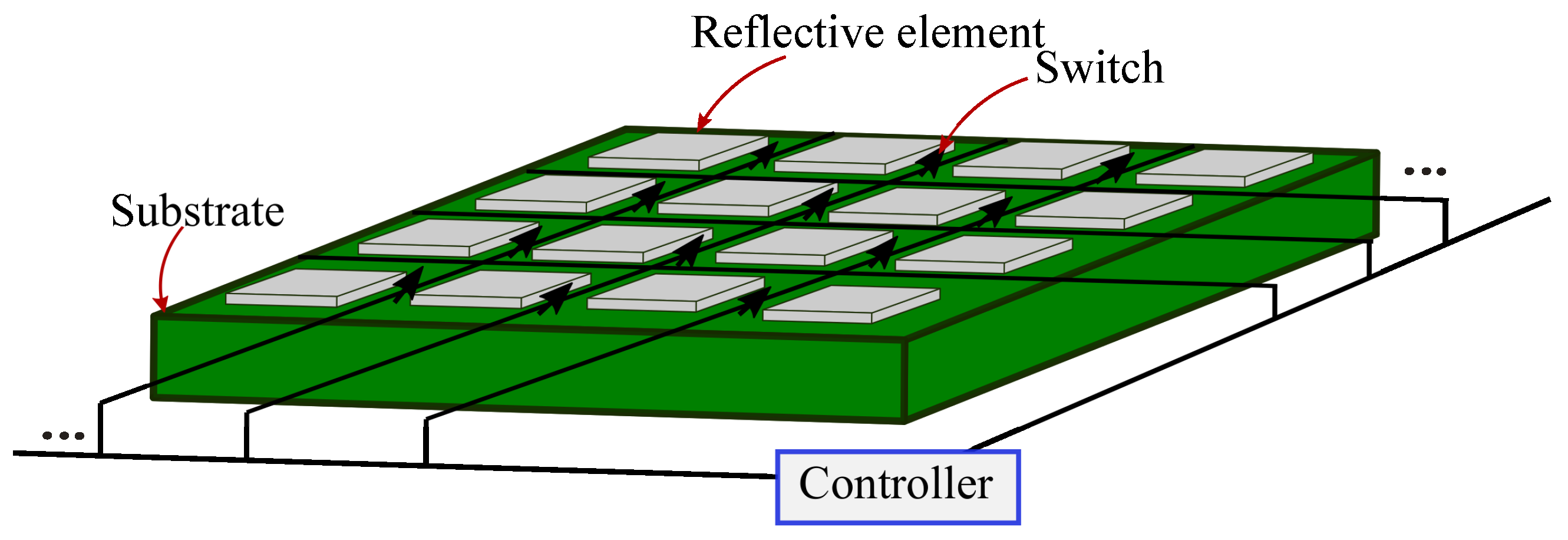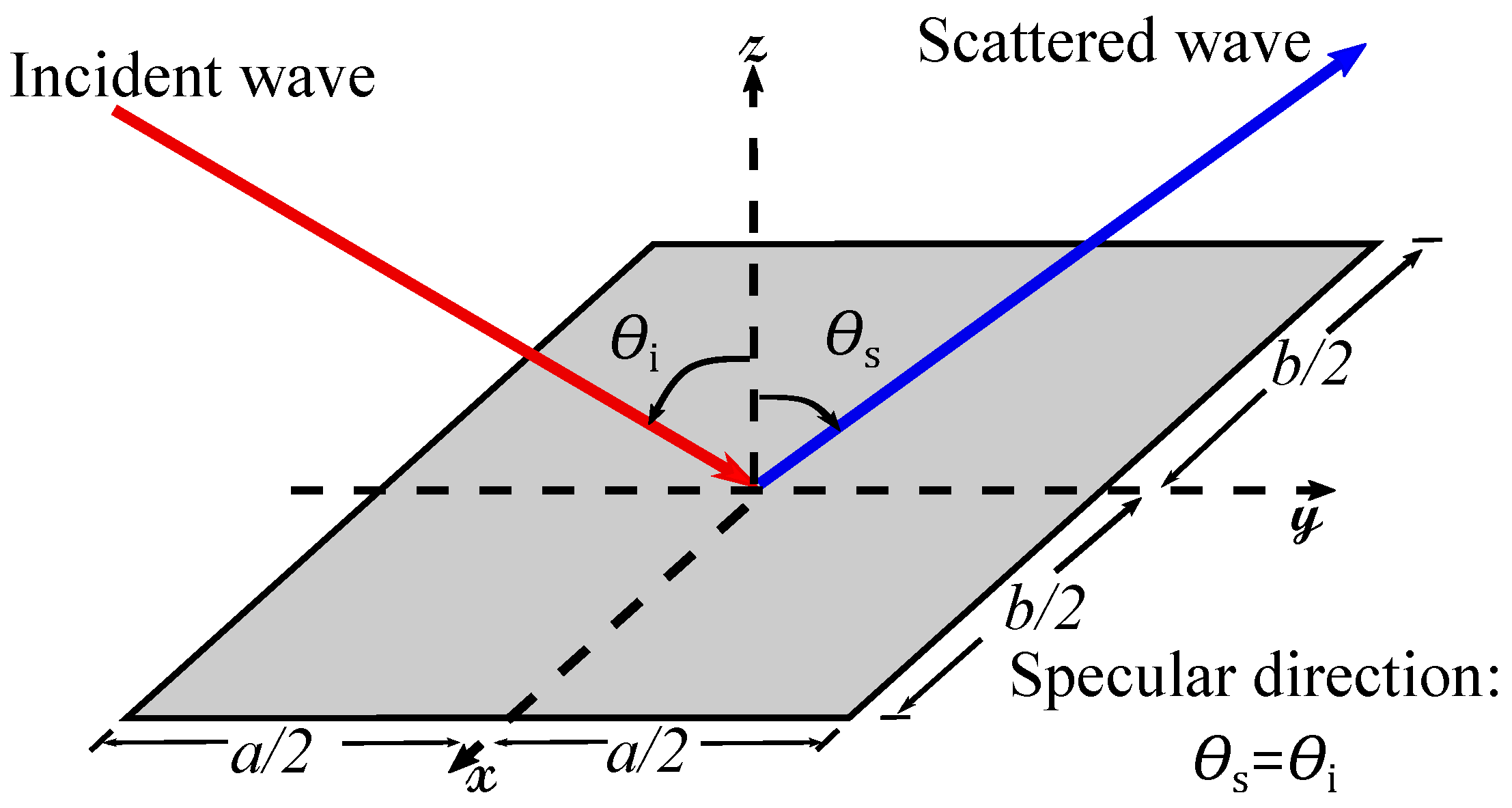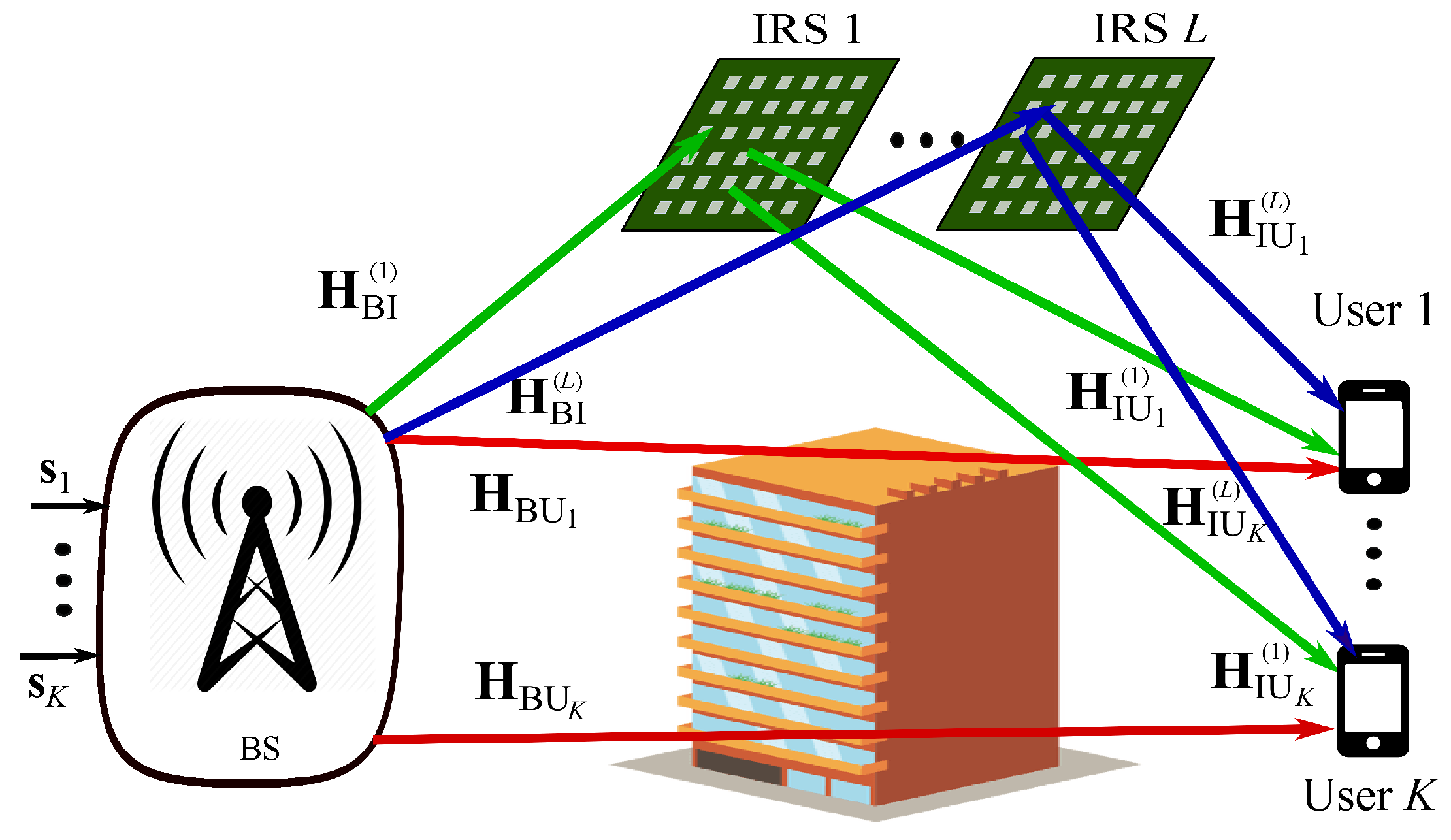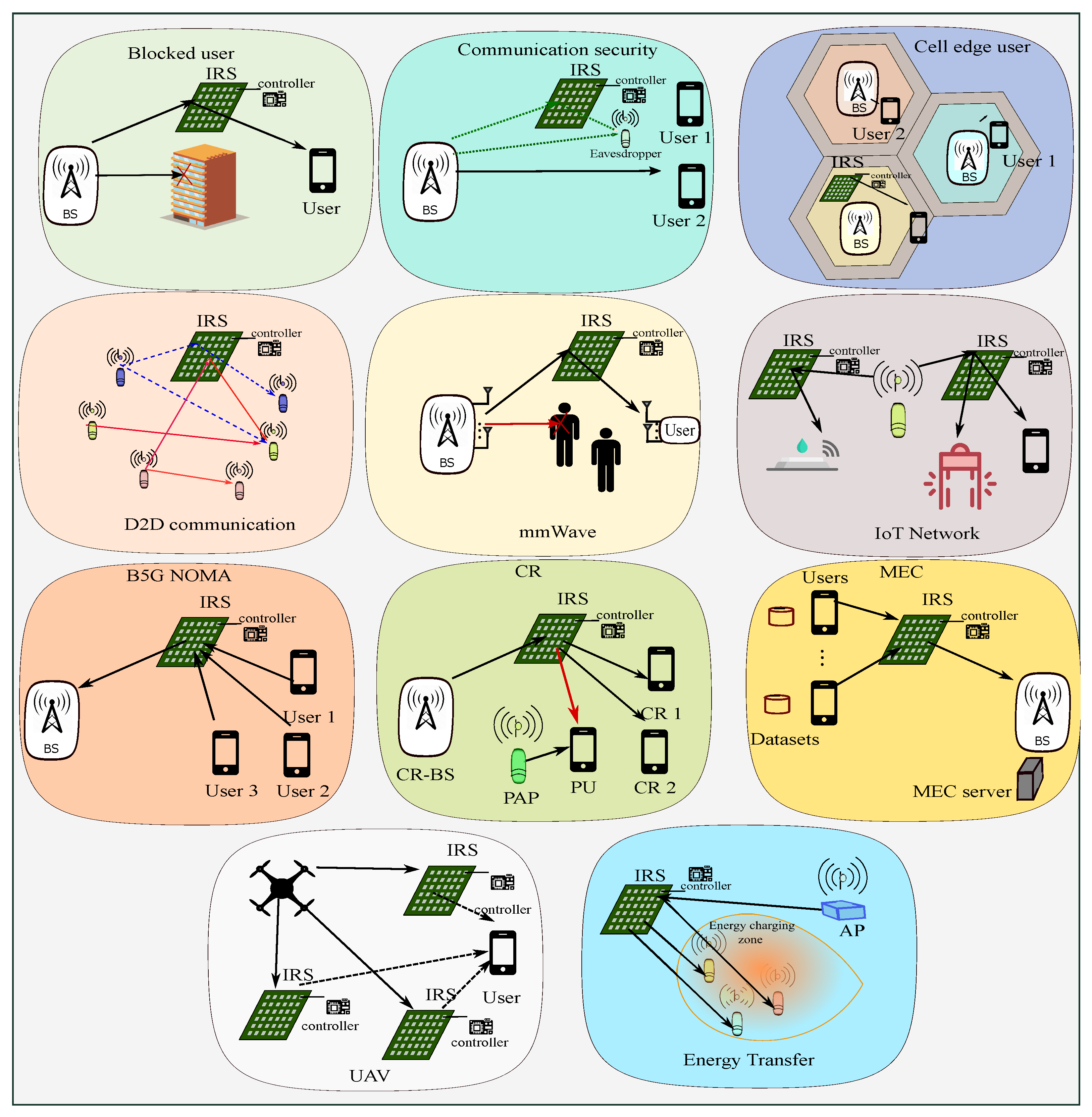The design of IRSs is a novel and challenging issue under the signal processing point of view. However, some recent works can be found in the literature that consider different setups and different metrics to design the IRS phase-shift matrix. We group the analyzed works according to the configuration of the communication setups, i.e., the number of transmit/receive antennas, and we also distinguish between single and multiuser scenarios. Within each group, the works address different communication scenarios with different characteristics, such as narrowband or wideband transmissions, LOS or NLOS links, perfect or imperfect CSI, and they also consider different metrics to optimize the overall system performance.
3.3.1. Single-User SISO Scenario
In [
6] a single-user SISO scheme with LOS conditions has been considered. The authors proved that the optimal IRS phase-shift setting is the setup that aligns the reflected rays to the direct path between the BS and the users. The paper also compares the IRS technology with conventional decode-and-forward (DF) relaying showing that the IRS needs hundreds of reconfigurable elements to reach a behaviour similar to that of the DF relaying. Additionally, the IRS achieves higher energy efficiency (EE) than DF relaying if very high rates are needed. By considering a simple LOS scenario where the IRS is deployed between a BS and the user to assist the communication, the optimized selection of the phase of each discrete element in the IRS leads to phase alignment of the direct path (BS to user) and scattered paths (BS to IRS to users).
In [
50], a point-to-point SISO system assisted with multiple IRSs is considered. The authors present multi-layer perceptron NN architectures that can be trained either with positioning values or the channel coefficients. Both centralized and individual training of the IRSs are proposed. The simulation results show that achievable rates close to the optimum scheme can be achieved.
Some works consider single-user point-to-point OFDM systems. The authors in [
51] approach the optimization of the IRS phase-shift matrix in a single-user SISO OFDM system with blockage of the direct paths between both ends, i.e., NLOS. Specifically, the authors develop a deep reinforcement learning (DRL)-based framework—which requires minimal training overhead—to solve a non-convex optimization problem by considering few active elements at the IRS and imperfect CSI. The results show that the proposed DRL-based framework is near optimum in terms of rate and converge to the solution with perfect CSI. A single-user SISO OFDM IRS-assisted system is considered in [
52], where a ML solution to design the IRS phase-shift matrix is employed. The solution exploits DL tools to learn how to predict the proper IRS matrix configuration directly from the sampled channel knowledge. The simulation results show that the proposed solution can achieve near-optimal data rates with negligible training overhead, without any knowledge of the IRS geometry.
The authors in [
53] also consider a system with imperfect CSI. Specifically, a point-to-point SISO with LOS conditions between both ends is assumed. Two solutions for the design of the IRS phase-shift matrix are proposed. In the first approach, the authors employ compressive sensing strategy to construct the channels by considering a few active elements at the IRS. In the second approach, a DL-based solution where the IRS learns how to interact with the incoming signals given the channels coefficients at the active elements. The achievable rates assessed in the proposed solutions approach the upper bound with perfect CSI, with minor training overhead.
The authors in [
54] consider an uplink single-user cellular network and derive an approximation of the achievable data rate by considering a practical IRS implemented via phase shifters with a limited resolution, i.e., discrete phase shifts. A derivation of the required number of phase shifts under a data rate degradation constraint is performed.
Table 1 summarizes the references related to single-user SISO systems, their system model assumptions, the performance metrics considered for the optimization, and the main results obtained.
3.3.3. Single-User MISO/SIMO Scenarios
The authors in [
57] propose a suboptimal semidefinite relaxation algorithm to maximize the total received signal power by a single-user communicating with a multi-antenna access point (AP) in LOS conditions. The simulation results exhibit performance gains over baselines (e.g., systems without IRS) in terms of the received signal-to-noise ratio (SNR).
In [
58], a DL-based approach for the design of the IRS phase-shift matrix in a single-user MISO system is proposed. Specifically, a customized deep NN is trained offline by using the unsupervised learning mechanism, which is able to make real-time predictions when deploying online. The simulation results show that the proposed approach offers slightly lower system performance than the semidefinite relaxation based approaches in [
57] in terms of rate while it significantly reduces the computation complexity.
In [
59], a DL approach has been developed to tune the IRS phase-shift matrix in real-time by considering a MISO system with LOS, i.e., a direct link is available between both ends. Simulation results show that the DL approach leads to performance comparable to that of conventional approaches while significantly reducing the computational complexity.
In [
60], a DL approach which learns and makes use of the local propagation environment is deployed for the configuration of the IRS phase-shift matrix in a downlink single-user MISO system with LOS conditions and imperfect CSI. The proposed method uses the received pilot signals reflected through the IRS to train the network. The performance of the proposed approach is evaluated in terms of the NMSE between the phases obtained by the proposed algorithm with imperfect CSI and the optimal IRS phases based on perfect CSI.
Table 3 summarizes the main results, system model assumptions, and evaluation performance metrics of the papers analysed in this subsection.
3.3.4. Multiuser MISO/SIMO Scenarios
In [
24] an IRS-assisted multiuser MISO system with LOS between a common AP and the users is considered. In particular, a practical phase shift model that captures the phase-dependent amplitude variation in the element-wise reflection design at the IRS is proposed. An optimization problem to minimize the total transmit power at the AP by jointly designing the AP transmit precoder and the IRS phase-shift matrix subject to the users’ individual SINR constraints is stated. Then, an AO algorithm is proposed to find suboptimal solutions. The simulation results show the asymptotic performance loss of the optimized IRS-assisted system when it is implemented with practical phase shifters and the obtained gains by optimizing with the practical model under consideration. The work in [
61] also considers the practical limitations of the IRSs. In particular, the authors have studied the asymptotic achievable rate in an IRS-assisted downlink MISO system. The system model considers a common BS transmitting to
K users by employing time-division multiple access (TDMA) to serve one user at each time slot. Multiple IRSs are deployed in a scheme where some users are IRS-aided and the others are directly served by the BS. The optimality of the asymptotic performance has been analyzed by considering the practical limitations of the IRSs, e.g., the practical reflection coefficients. In this context, an IRS phase-shift matrix design is proposed, which is able to asymptotically achieve the optimal performance. The results are presented in terms of the symbol-error-rate (SER) and the ergodic rate and compared with a baseline strategy without IRS and the AO algorithm proposed in [
24].
The authors in [
62] consider a multiuser IRS-assisted SIMO system, where the uplink transmissions are reflected by the IRS. An approximated zero-forcing (ZF) equalizer is implemented to cancel the inter-user interference in a decentralized way by optimizing the IRS phase shifters (see [
62], Algorithms 1 and 2). The results are presented in terms of the signal-to-interference ratio (SIR) and show better performance than a single daisy chain realization of the algorithm in [
63] to compute the equalization vector.
Some works related to non-orthogonal multiple access (NOMA) IRS-aided systems have been considered. In [
64], an IRS-aided multiuser MISO NOMA downlink transmission framework is proposed. The authors assume NLOS between the users and the BS. An optimization problem to maximize the sum rate is formulated. For adjusting the IRS phase-shift matrix, a deep deterministic policy gradient (DDPG) algorithm, which dynamically learns the resource allocation policy is defined. The proposed framework achieves a sum rate larger than the one assessed with traditional orthogonal multiple access (OMA) networks.
In [
65], an IRS-assisted NOMA MISO downlink system is considered. The authors consider the joint optimization of the beamforming vectors at the BS and the phase-shift matrix at the IRS to minimize the total transmission power consumption at the BS. The problem is solved via an AO minimization approach and the results exhibit that this solution leads to transmission power reductions by comparing with a baseline strategy, which imposes random phase shifts at the IRS.
In [
66], the authors consider the uplink of a cluster-based multiuser code-domain NOMA IRS-assisted MISO system. It is considered a setup where each IRS is covering a cluster of users, which have NLOS conditions with the BS. The optimization of the IRS phase-shift matrices such that a large number of users are correctly detected is approached. To overcome the coupling between the IRS phase shifts and other variables, such as the detection order and the filter, a sum-rate optimization is used to obtain a decoupled estimate of those variables. Then, the final IRS adjustment is performed via an semidefinite programming (SDP) relaxation of the optimization problem. Simulation results show the performance gains obtained (measured in terms of the number of correctly detected users) with respect to a random phase shift implementation when the IRS phases are properly optimized.
In [
67], the authors consider a multiuser MISO IRS-assisted NOMA downlink system with NLOS conditions. The IRS-assisted NOMA system is designed to ensure that additional cell-edge users can be served by the BS. Both analytical and simulation results are provided to show the performance of the proposed scheme in terms of the outage probability. Hardware impairments are also analyzed.
In [
68], the authors address a multiuser MISO IRS-assisted mmWave communication system. The motivation is to enhance the network reliability and connectivity in the presence of random blockages in mmWave, which usually implies NLOS. A stochastic optimization problem based on the minimization of the sum outage probability is formulated, and a stochastic-learning-based robust beamforming design is proposed via a gradient descent algorithm. The numerical results validate the performance benefits of the proposed algorithm in terms of outage probability and effective data rate over baseline strategies (non-IRS, random IRS).
In [
69], a DRL-based algorithm for the configuration of the IRS and the BS beamformer is developed in a downlink IRS-assisted multiuser MISO system. The proposed DRL-based algorithm obtains the design of the BS precoder and the IRS phase-shift matrix as the output of the DRL NN from the instantaneous channel estate information. Simulation results show that the algorithm is not only able to learn from the environment and improve its behaviour but also obtains comparable but lower performance than [
70]. The work in [
70] proposes two EE maximization algorithms for the BS transmit power allocation and the IRS phase-shift matrix in a downlink multiuser MISO system with NLOS. The results are presented in terms of EE and show that the proposed solution offers higher EE than the Amplify-and-Forward (AF) relay-assisted setup.
The authors in [
71] present an infrastructure to perform ML tasks at a mobile edge computing (MEC) server with the assistance of an IRS in a multiuser MISO system. Therein, they aim at maximizing the learning performance. Specifically, a minimization of the maximum learning error (MLE) of all participating users is performed by jointly optimizing the transmit power of mobile users, the beamforming vectors of the BS, and the phase-shift matrix of the IRS. An AO-based framework is proposed to optimize the three terms iteratively, where a successive convex approximation (SCA)-based algorithm is proposed to solve the power allocation problem, closed-form expressions are derived to solve the beamforming design problem, and an alternating direction method of multipliers (ADMM)-based algorithm is designed to efficiently solve the phase-shift matrix design problem. Simulation results show significant gains when deploying the IRS over baseline strategies.
Several works related to the IRS phase-shift matrix design assume imperfect CSI. In [
72,
73] the authors propose a ML approach to optimize both the beamformers at the BS and the IRS phase-shift matrix in a multiuser MISO system. Such an approach employs a deep NN to parametrize the mapping from the received pilots to an optimized system configuration, then a graph neural network (GNN) architecture is considered to capture the interactions among the different users in the cellular network. Furthermore, the authors propose an implicit channel estimation, which is generalizable and leads to an efficient learning to maximize the sum rate by considering a small number of pilots.
In [
74] a downlink multiuser IRS-assisted MISO system is considered. Both perfect and imperfect CSI scenarios are addressed under the assumption of LOS between the common AP and the users. For the perfect CSI setup, an algorithm is proposed to maximize the weighted sum rate of the system by utilizing the fractional programming technique. This algorithm is then extended for the imperfect CSI setup. The simulation results are presented in terms of the weighted sum rate and show the performance gain offered by the proposed algorithms over benchmark strategies without IRS. However, these algorithms present high computational complexity.
In [
75], a multiuser MISO multi-IRS-assisted system with unavailable direct link conditions between the users and the BS (NLOS conditions). The IRS phase-shift matrices are configured by exploiting the statistical CSI in an imperfect CSI scenario. In particular, two ML algorithms have been proposed, which learn the statistical CSI from the historical channel observations. Numerical results show the largest gains in terms of rate when the channel randomness is low.
In [
76] the authors investigate the IRS design under imperfect cascaded BS-IRS-user CSI in a multiuser MISO system with LOS between both ends. They aim to minimize the transmit power subject to the rate outage probability constraints by considering a statistical CSI error model. The minimization problem is reformulated by following a Bernstein-type inequality and has been solved via an AO framework.
In [
77], a cognitive radio (CR) MISO downlink IRS-system is considered. Specifically, a single secondary user is coexisting with multiple primary users and multiple IRSs are deployed to enhance the EE and the SE of the system. The authors aim to maximize the achievable rate of the secondary user subject to a total transmit power constraint by considering imperfect CSI. Simulation results show the system performance improvement by including the IRS technology in the CR network.
The authors in [
78] propose a DL method for online reconfiguration of the IRS in a SIMO complex indoor environment. The IRS phase-shift matrix configuration is set according to the receiver position to maximize the rate. The simulation results are presented in terms of the rate and the MSE between the output of the NN (the IRS phase-shift matrix) and the optimal phase-shift matrix for a given user position.
The authors in [
79] consider an IRS-aided multiuser MISO downlink system, where the transmit beamforming and the IRS phase-shift matrix are jointly designed to maximize the system sum rate. The solution is a DL-based approach to perform the joint design. Specifically, a two-stage NN is implemented and trained offline in an unsupervised manner, and it is then deployed online for real-time predictions. Simulation results exhibit substantial reductions in the computational complexity with satisfactory performance compared to conventional iterative optimization algorithms as in [
74] (see [
79],
Table 1).
The work in [
80] considers the use of an IRS to enhance anti-jamming communication performance and mitigate jamming interference by properly adjusting the IRS elements in a multiuser MISO system under NLOS conditions between the users and the BS. The problem formulation is performed as a joint optimization of the power allocation at the BS and the IRS phase-shift matrix while considering quality of service (QoS) requirements for legitimate users. A fuzzy win or learn fast-policy hill-climbing (FWoL-FPHC) approach is proposed to jointly optimize the anti-jamming power allocation and the IRS phase-shift matrix. Simulation results show that the proposed anti-jamming learning-based approach can efficiently improve both the IRS-assisted system performance (measured in terms of rate) and the transmission protection level compared with the mmWave massive MIMO approach presented in [
81].
In [
82] a downlink multiuser IRS-aided MISO system is considered, where the IRS only presents a finite number of phase shifts at each element to assist the communication. A transmit power minimization approach is developed by jointly optimizing the transmit precoding at the BS and the discrete phase shifts at the IRS, subject to a given set of minimum SINR constraints at the user receivers. To solve the problem, the authors first study the case where only one user is assisted by the IRS and propose both optimal and suboptimal algorithms for solving it. It is also shown that the IRS with discrete phase shifts achieves the same squared power gain in terms of an asymptotically large number of reflecting elements, while a constant proportional power loss is incurred depending on the number of phase-shift quantization levels. The proposed designs for the single-user case are also extended for the multiuser scenario where some of them are aided by the IRS. In the simulation results, comparisons with several benchmark schemes regarding the quantization in the IRS elements are performed.
The authors in [
83] consider the passive beamforming and information transfer (PBIT) technique for an uplink multiuser IRS-assisted SIMO systems. The IRS is assumed to follow a passive beamforming (phase shifting) and an on–off reflecting modulation. The authors formulate the problem as a two-step stochastic problem and aim to maximize the achievable user sum rate of the system. An sample average approximation (SAA) based iterative algorithm and a simplified algorithm by approximating the stochastic program as a deterministic AO problem is proposed for the IRS phase-shift matrix design. The solutions are extensible for multi-IRS system models. The simulation results exhibit the large gains offered by the proposed approach over a random phase-shift strategy at the IRS.
Table 4 summarizes the review about multiuser IRS-assisted MISO/SIMO approaches. The considered system models, the metrics to evaluate the performance, and the main results are included.













